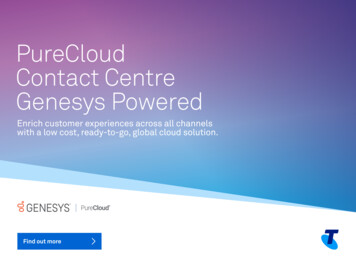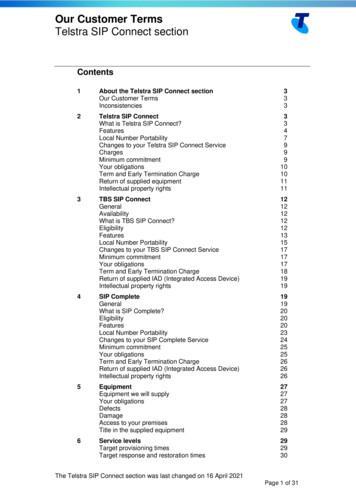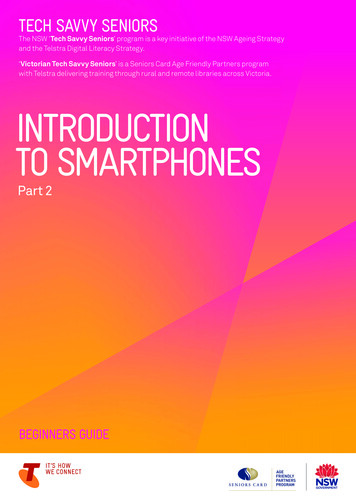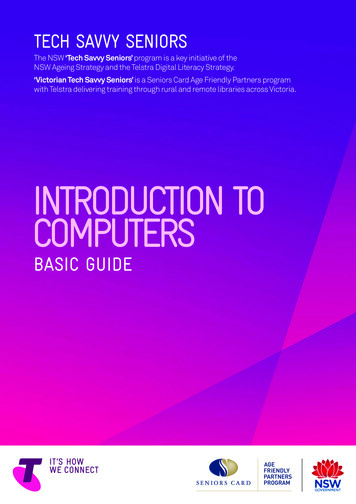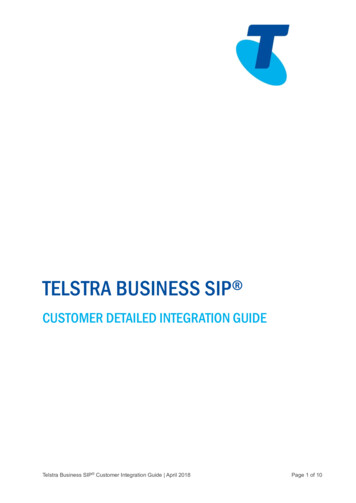
Transcription
THE DIGITALinvestor1
1.0Executive Summary1.1The wealth management industry is undergoing a digital transformation1.2The ‘Digital Affluent’ Gen X and ‘Digital Heir’ Gen Y are the masters of digital technology1.3 The Digital Affluent and Digital Heirs have driven the shift in the ‘path to purchase’ for wealth management productsand services1.4Digital mastery and appetite for wealth management haven’t translated into confidence in managing finances1.5Wealth managers are holding advisers back1.6 The Digital Affluent and Heirs want their wealth managers to provide digital services today – and doing so, wouldsubstantially improve performances1.7Emergence of Video, Mobile and Collaboration with experts as key digital channels1.8Choreographing personalised, context aware, predictive interactions to the ‘Connected, Collaborative, Social’ investor25555666892.0 Major Wealth Management Industry ChallengES102.12.21013Inter-generation wealth transferThe Digital Investors – Generation X and Y3.0 Consumer, Financial Planner and Digital Investor Research163.13.23.33.4MethodologyGeneration X and Y wealth management research – How are they changing the path to purchase?Financial planner research – How technologically equipped are those that serve them?The Digital Investor study – How ready are they for digital wealth services?161620244.0Technology and the Digital Investor304.14.24.34.44.54.64.7The Connected InvestorThe Collaborative InvestorThe Social InvestorOrchestration and choreography – Digital channel ecosystemPersonalisation and context-awarenessIntelligent predictive customer serviceOrchestration and choreography – Virtual personal assistants313537373840415.0 ConclusionS446.0 about the author457.0 acknowledgements468.0 NOTES AND REFERENCES47
3
forewordWelcome toTelstra’s latestfinancial servicesthought leadershipreport: The DigitalInvestor. Thisreport is the eighthin my series ofthought leadershipreports and hasbeen producedin collaborationwith some of Australia’s leading wealthmanagement researchers.The wealth management industry isfacing two major tectonic shifts. Firstly,the industry is facing the greatest intergenerational transfer of wealth in historyfrom Baby Boomers to Generations X and Y.This reality presents two major strategicissues. On the one hand, how do wealthmanagers maintain the loyalty and assetsof the Boomers? On the other, how do theydevelop propositions of relevancy to theyounger generations. The second shiftrelates to the digitisation of the way we live,work and play and the industry’s responseto this technological transformation. Gen Xand Gen Y have grown up in an environmentwhere ubiquitous connectivity, collaborationand social media is deemed as essential asfood and water and many traditional formsof interaction have been replaced withvirtual communication.This report examines what Gen X (referredto in the report as the ‘Digital Affluent’)and Gen Y (referred to as the ‘Digital Heirs’)expect from their wealth managers.4The research analyses their attitudestoward a range of digitally enabled wealthmanagement experiences. We then explorethe impact on customer experiencedesign and provide perspectives on theorchestration of media and communicationstechnologies to choreograph greaterpersonalisation, context awareness andprediction in wealth management servicesand their associated delivery.These tectonic shifts will foster a new periodof industry innovation and transformationcreating the opportunity to translate growthpotential into a much larger serviceableaddressable wealth management market.With digital communication technology atthe epicentre of the new ‘Digital Investor’ era,I hope this report provides the necessaryinsights to shift digital from being an adjunctto your strategy to a core component of yourbusiness architecture.To the many industry contributors to thisresearch, I thank you for your insights.Rocky ScopellitiGroup General Manager – Industry ExecutiveTelstra Enterprise & Government
1.0 EXECUTIVESUMMARYOver the next 20 years, the share of financial assets held byGenerations X and Y will grow from 36% in 2010 to approximately70% in 2030. The significance of this will be felt across manyaspects of Australian society.1.1 The wealth managementindustry is undergoing adigital transformation1.2 The ‘Digital Affluent’ Gen Xand ‘Digital Heir’ Gen Y are themasters of digital technologyOver the next 20 years, the share of financialassets held by Generations X and Y will growfrom 36% in 2010 to approximately 70%in 2030. The significance of this will be feltacross many aspects of Australian society.For example, today, 60% of AustralianMicro Business owners (those that employbetween 1-5 people) are Pre Boomers (20%)and Baby Boomers (40%) and as SocialAnalyst Mark McCrindle writes “Successionplanning is already a key issue (for SMEs)– yet by 2020 40% (145, 786) of today’smanagers in family and small businesseswill have reached retirement age. We areheading towards the biggest leadershipsuccession ever.” 1As pioneers of the modern digital era, theDigital Affluent investor (Gen X) has beenintimately intertwined with three keytechnological revolutions: the introductionof the personal computer (dominated byMicrosoft and Apple – both companies whichhappened to be founded in the 1970’s), theunstoppable rise of the internet and lastly,the mobile revolution. The Digital Affluent arethe backbone of the Australian employment– representing 44% of the Australianworkforce in 2012. They also hold 25% oftotal assets and they carry the largest shareof the total debt at 47%.This shift in assets from the oldergenerations to the younger generationswill have significant consequences for thewealth management industry for a varietyof reasons – changes to asset preferences,importance of investment objectives, riskpropensity, and technology adoption to namebut a few. The new generation of investorswill require management in very differentways. Whilst there have been considerableadvances in the wealth managementindustry recently, including an increasingpush into digital customer management, theindustry still has considerable opportunitiesto further leverage technology. This will openup a range of new revenue models for theastute wealth manager, whilst threateningthe businesses of those who cannot or willnot adapt. Welcome to the era of the DigitalInvestor (see Section 2.1).The Digital Heir investors (Gen Y) representthe most highly educated, connected andmedia saturated generation in history. Theyare also driving revolutions such as theexplosive rise of social media, which hasfundamentally re-written the ‘rules of thegame’ for how people and organisationsinteract. Digital Heirs have becomeaccustomed to the rapid rise of companiessuch as Google, Amazon, eBay, PayPal,Twitter, YouTube and Facebook, whoseorigins straddle the change in millennium.By 2020, Gen Y is predicted to represent 35%of the Australian workforce. Whilst todaythey may only hold 11% of total assets, theyare predicted to be major benefactors of thetransfer of wealth from their Baby Boomerparents. They expect to start their economiclife in the same prosperity in which they’veseen their parents finish theirs(see Section 2.2).1.3 The Digital Affluent andDigital Heirs have driven theshift in the ‘path to purchase’for wealth managementproducts and servicesAs at December 2012, the Digital Investorscollectively held 71.6% of the total marketdebt, whilst only holding 36.1% of the totalmarket assets signifiying their reliance ondebt to accrue assets. Their appetite hasbeen reflected in the market for wealthmanagement products with the proportionof Australians (14 years and over) holdingwealth management products increasinggradually from 68.5% in 2008 to 71.1% in2012. During the same period, the proportionof Digital Heirs holding wealth managementproducts surpassed that of the previousbenchmark-setters, the Baby Boomers.Whilst the face-to-face channel is still themajor channel used to purchase wealthmanagement products, there is a significantshift toward the internet, particularly forDigital Investors. Importantly, the internet isnow the primary media used for searchingand selecting finance and investmentproducts (see Section 3.2).5
1.0 EXECUTIVESUMMARY (cont.)1.4 Digital mastery and appetitefor wealth management haven’ttranslated into confidence inmanaging financesDespite their confidence with, and evenmastery of, digital technologies and thefire hose of information and services thesetechnologies provide access to, almost halfof the Digital Affluent and Digital Heirs (46%and 45% respectively) don’t feel confidentmanaging their finances (see Section 2.2).In fact, the Digital Investors are the leastconfident of all age groups when it comesto managing their finances – only 17%strongly agree that they feel confidentabout managing finances. This highlightsan ongoing and valued role for professionaladvice with regard to management ofpersonal finances and investments(see Section 3.2).1.6 The Digital Affluent andHeirs want their wealthmanagers to provide digitalservices today – and doing so,would substantially improveperformanceWe presented Australian Digital Affluentand Digital Heir consumers who are opento wealth management solutions with fivedigital technology concepts and tested thesefor both appeal and business impact. Overallthe concept scores were high, with eachbeing found appealing by between aroundone quarter to one half of respondents. Foreach concept, more than one in six DigitalInvestors indicate a propensity to use theconcepts (see Table 1). The majority (70% onaverage) of those interested in the concepts(i.e those who found the service appealingand would like to use) would like to accessthese services through laptops.Other preferred devices were smartphones(59%), tablets (54%) and desktop computers(48%). In terms of preferred channels ofconnecting to the services, an overwhelmingmajority (80% or more) mentioned websitesas a preference. YouTube shows goodpotential, most notably for EducationalVideos (48% preference). Social media sitesalso show good potential with, on average,a third (31%) of potential concept userspreferring to connect to the services throughsocial media.To better understand the relationshipsbetween the subgroups that found thevarious concepts appealing, we analysedwhich combination of the digital technologyconcepts ensured the greatest reach. Theproportion that finds at least one conceptappealing increases from 47% for oneconcept to 74% for all five concepts(see Chart 1).1.5 Wealth managers areholding advisers backOver the past five years, technology hassignificantly appreciably transformedadvisers’ practices and will play a far greaterrole into the future. Conversely, advisersare increasingly frustrated with what theyperceive as a failure on the part of wealthmanagers to keep up with technologicalevolution. Mobility is critical to adviserswith almost half (47%) conducting theirwork from home at least a few times perweek and 41% reporting working frommultiple locations.Financial planners have embraced tabletswith one in three using an iPad when workingon the go. The need for wealth managersto cater to the growing tablet market ishighlighted by the fact that 12% of advisersuse only a tablet when working away fromthe office. Of those, 25% use the tablet as areplacement for a laptop computer.Despite the technological sophisticationof advisers, wealth managers are failingto deliver with only a third satisfied withtheir dealer groups use of technology andinnovation with technology/software/applications (see Section 3.3).6Chart 1: % Appeal of digital wealth concepts and combinations results210090807070646050474030C. EducationalVideosC. EducationalVideosD. Alert Services20C. EducationalVideosD. Alert ServicesB. OnlineCollaborationwith an Expert10074721 concept2 concept combo3 concept comboC. EducationalVideosC. EducationalVideosD. Alert ServicesD. Alert ServicesB. OnlineCollaborationwith an ExpertB. OnlineCollaborationwith an ExpertA. AccessingExperts onDemandA. AccessingExperts onDemand4 concept comboE. ‘Intelligent’Assistants5 concept comboImportant note: These levels of appeal are based on specific concept combinations as shown.
7
1.0 EXECUTIVESUMMARY (cont.)For the individual concepts, the proportionof Digital Investors who are interestedin the concepts (i.e. those who found theservice appealing and are likely to use) andwho indicated that the concept was likelyto increase their satisfaction with theirfinancial services provider ranged between14% and 31%.The proportion indicating the concept wouldincrease their likelihood to recommend theprovider to family, friends and colleaguesvaried from 14% to 29% – showing thepotential of these concepts to impactadvocacy as well as satisfaction. Between13% to 27% of Digital Investors who areinterested in the concepts indicated thatbased on the concepts, they would be morelikely to consider a provider when openinga new account and 13% to 26% wouldconsider them when switching provider –indicating such tools could help providersbuild their customer base (see Section 3.4).81.7 Emergence of Video, Mobileand Collaboration with expertsas key digital channelsThe score card in Table 1 shows the overallkey performance indicators for eachconcept. Overall, Educational Videos havethe broadest appeal (47%) followed by AlertServices (44%) then Online Collaborationwith an Expert (38%). Intelligent Assistantswere weakest on appeal (23%) – likely dueto their relatively recent emergence intomainstream market consciousness throughApple’s Siri (see Section 3.4).Respondents were asked to rate eachconcept on a number of attributes – theseratings were then compared to the sameattributes ratings for their current mainfinancial services provider, financial planner/adviser or wealth manager/adviser.The concepts Educational Videos andAccessing Experts on Demand were shownto be likely to improve ease of understandingproducts. Educational Videos and OnlineCollaboration with an Expert are likely tofundamentally improve the distribution ofinformation, with significant improvementsacross several dimensions (ease of access toinformation, convenience and engaging wayof providing information). Access to financialexperts when needed was also significantlyimproved by the two concepts offeringaccess to a real person (Accessing Expertson Demand and Online Collaboration with anExpert) (see Section 3.4).
1.8 ChoreographingPersonalised, Context Aware,Predictive interactions to the‘Connected, Collaborative,Social’ investorThe Digital Affluent and Digital Heirs arethe most informed, media saturated andconnected generations ever. Smartphones,tablets and laptops are the key accesspoints for these consumers and, just asimportantly, they are also key devices fortheir advisers. Being connected anywhereat anytime to any media on any devicehas trained these generations to expectimmediate, well considered, well designed,and well informed service interactions.Their delivery can be orchestrated throughmodern cloud-delivered ICT such as unifiedcommunications, IP multichannel contactmanagement, content management anddistribution systems, and integratedmessaging. Finally, we show a glimpse of theemerging future of Virtual Personal Agentsand intelligent personal assistants, whichcan be seen as a logical extension to today’sofferings, and bring all of these technologiestogether through a single, unified andnatural interface (see Section 4).By effectively employing information,media and communications technologieswealth managers can choreographcustomer experiences that meet thesehigh expectations. In doing so, they can notonly create engaging services, but can alsoextend their reach and substantially reducethe cost of interacting with customers.Through this strategy wealth managers andfinancial advisers have the opportunity toboth grow their addressable market andcapture a greater share of it. Creating DigitalEcosystems that embody personalisation,collaboration, social media, contextawareness and predictive analytics are allimportant enablers for these interactions.Table 1: Summary of digital enabled services appeal and business impact3CONCEPT APPEALING. LIKELY TO USE AND RESULTS INConcept/Impact Score CardA. Accessing Expertson Demand (%)B. Online Collaborationwith an Expert (%)C. Educational Videos(%)D. Alert Services (%)E. ‘Intelligent’Assistants (%)3338474423APPEALING AND LIKELY TO USE2427473734MORE SATISFIED WITH WEALTH PROVIDER2024312814MORE LIKELY TO RECOMMEND2123292714MORE LIKELY TO CONSIDER WEALTHPROVIDER WHEN OPENING A NEW ACCOUNT20232727131922262513MORE LIKELY TO CONSIDER WEALTH PROVIDERWHEN SWITCHING9
2.0 Major WealthManagement IndustryChallengeSWe begin our exploration by considering two major challenges facingthe wealth management industry today.The first is an inter-generational transfer ofwealth occurring on an unprecedented scale.The second is the fundamentally differentexpectations of the Digital Investors whowill be the recipients of that wealth.These issues and the way the industryresponds to them, will forever changewealth management.2.1 Inter-GenerationWealth Transfer2.1.1 Trends in wealth transferAustralia is a wealthy, highly developednation and a good proportion of itspopulation holds considerable investablefinancial resources across a range ofasset classes. Throughout history theseassets have been passed from generationto generation, with little change in how89%the major asset classes are investedor managed from one decade to the82%next – although recent developmentsin compulsory super contribution andincreased personal debt levels have hadsome impacts (see Chart 2).With the Australian economy booming overmany decades, assets in many classes havegrown substantially. To name but a few,rising property and land values, commodityfuelled growth, major resource projectsincreasing income levels and mandatorysuperannuation contributions have allcontributed to huge increases in personal83%wealth (see Chart 3).However the rapid adoption of quicklyevolving digital technologies means thewealth management industry is aboutto experience significant change. Oldergenerations, historically slower adoptersof technology are now embracing digital inincreasing numbers. They are also aboutto pass their wealth to a generation whohave grown up in an environment whereubiquitous connectivity is deemed asessential as food and water and wheremany face-to-face interactions have beenreplaced with digital communications(see Chart 4).Chart 2: Asset 980Gov securities and other199020002010Equities and trustsLife and superDepositsCashNote: Treasury data has been used up to Year 2000. From 2000, the figures are based on various RBA and ABSdata and are therefore estimates only.Chart 3: Total wealth held in bn per asset category, 1960 to 01980Gov securities and other199020002010Equities and trustsLife and superDepositsCashNote: Treasury data has been used up to Year 2000. From 2000, the figures are based on various RBA and ABSdata and are therefore estimates only.10
Chart 4: Median wealth held in 000s by different age groups in 2012 6700600500through to the higher involvement equitytransactions, and high frequency tradingand derivatives trading. In order to manage acomplex heterogeneous portfolio, investorsrequire access to information that isaccurate, highly relevant and on the righttime scale in the context of each class ofinvestment.RegulationThe regulatory environment in Australia andglobally is complex and whilst efforts arebeing made to make the regulations moreuniform, their obligations must be satisfiedregardless of the channel used for wealthmanagement. This will become even moreimportant when the FOFA reforms becomemandatory from 1st July 54Life insurance55-6465-74 75 & overDepositsWhilst Gen X and Y currently hold about 36%of total assets, a process of wealth transferis underway that will see these generationsholding an estimated 70% of wealth by 2030.This has significant implications for thewealth management industry. Customers, oldand young, are becoming more self-directedin managing their wealth, partly a result ofthe Global Financial Crisis. Although they aredemanding more control of their investmentsand immediate access to exercise thatcontrol, the number of customers wantingquality paid-for investment advice is growingand as outlined in Section 3.2, an increasingnumber are happy to receive this advicethrough digital channels. Combine this with anew era of globally linked economies, diverseinvestment options, increasing demandfor social and ethical investment optionsand greater visibility of the performance ofboth investments and those who managethem, and it becomes clear that both theopportunities and the risks for wealthmanagers are substantial.TrustsCashEquity2.1.2 Implications for wealth managementWealth management companies, like thosein many other industries experiencingdigital disruption, need to adapt quicklyand pragmatically to determine theirdigital strategy. They need to balance theincreasingly sophisticated needs of thedigital investor with the cost and complexityof execution, all within the constraints ofa highly regulated, cross-border financialenvironment. Some of the major implicationareas to be considered in such strategies are: Investment categories Regulation Expert advice Wrapped reporting Data analysis Addressability.Investment categoriesA typical investor will be balancing a rangeof investments across a number of assetclasses, each with different managementrequirements – from super funds whosemanagement approach is less day-to-dayDespite this complexity, digital investorsassume that regulatory requirements arebeing managed for them, either by theirwealth manager or through the digitalchannels they use to invest.In fact, digital channels provide a hugeopportunity for regulatory compliance sinceall interactions and investment activitycan be monitored, stored and reportedto the relevant authorities – providedthe platforms used keep up to date withcompliance requirements. By working withcompliance technologies, wealth managerscan actively support regulatory adherenceon behalf of their clients, and reduce theirown compliance risk for both foreign anddomestic investments.Expert adviceThe modern investor requires a range ofinformation services and advice and will aimto minimise face-to-face, time consuminginteractions where possible. Wealthmanagers must continue to manage theircustomer relationships, or risk losing theirbusiness. However, wealth managers mustalso manage the cost of customer contactson their various channels. The effectiveuse of channels such as online investmentreports, video advice, email and socialfeeds allows them to build the relationshipwith their customers in an economicallysustainable manner.11
2.0 Major WealthManagement IndustryChallengeS (cont.)Wrapped reportingWith the complexity and diversification ofinvestment options continuing to increase,the need for investors to be able to accessand visualise their entire portfolio in aneasy-to-digest format has never beengreater. Investors ideally wish to see alltheir investments in one place, and thento be able to drill into specific investmentcategories and decision-making options thatare tailored both to them and to the natureof the investment. This also allows themmore easily to manage their investments,risk profile, total financial exposure, taxreporting and regulatory compliance.12Data analysisDigital channels provide a wealth of dataregarding investor’s interests, decisions andtheir behaviours. The insights that can begleaned from that data are potentially veryvaluable. Wealth managers should work withtheir clients and with analytics advisers tomine that data for insights into the market,for opportunities to provide client-specificadvice and for opportunities to cross-sellor up-sell products and services in a highlytargeted manner.AddressabilityWith investors ever more mobile and evermore connected, they need instant access toinformation and advice anytime, anywhere.Marketing talks of the ‘always addressablecustomer’ – the flip-side of that equation isthe customer’s need and expectation thatthose who service them are also ‘alwaysaddressable’. The requirement for 24x7access has never been greater and wealthmanagers need mechanisms and strategiesin place to address that requirement.
2.2 The Digital Investors –Generation X and YThe second major structural challengefacing the wealth management industryrelates to creating services that meetthe needs of the Digital Investors – theGeneration X and Y customers to whom thewealth discussed in the previous section willbe transferred.As explained in my report in 2009, ‘ICT as adriver to improve service to Generation Y forfinancial services’, all generalisations about‘generations’ need to be treated cautiouslyas does specifically locating them withinbirth time periods. While it is true thateach generation is shaped by the powerfulcultural influences in their childhood andadolescent years, there is inevitably a largerange of individual differences in theirresponses to those formative influences.However, broadly based observations aboutthe influences that are likely to have shapedtheir emerging attitudes, values, motivationsand expectations can still be made.In this section, we will summarise fourimportant dimensions relating to theirtechnological, demographic, employmentand financial environment to help provideinsights into their expectations today.2.2.1 Generation X ‘The Digital Affluent’Generation X – those broadly born between1961 and 1975 – were in many respects, thepioneers of the modern digital era. They werethe first to experience the tsunami of newtechnologies that fundamentally changedthe way we live, work and play.This generation grew up in times ofeconomic prosperity yet only 17% stronglyagree they feel confident managing theirfinances. Unlike their parents, Gen Xbelieves in work-life balance and is a drivingforce behind key workforce trends such asremote and flexible working. One of the mostnotable social and economic shifts emergingfrom this generation is the dual-incomefamily. Today over two-thirds of partneredmothers with children under 10 years arecurrently participating in the workforce 7(see Figure 1).They witnessed the introduction of thepersonal computer, the introduction ofpersonal media devices such as the SonyWalkman and VCRs. They’ve also been sweptalong by the rise of the Internet and the birthof the mobile revolution.Today, Gen X holds 25% of Australia’s totalwealth, earns an average annual incomeof 64,044, and represent the largestproportion of the workforce (approximately44%). For the purposes of this report, I havelabelled them the ‘The Digital Affluent’.Figure 1: Generation X profile 8DEVICE OWNERSHIPTelevisionsLaptopsSmartphonesDesktop computerTabletsTECHNOL91%82%77%66%52%YOGEMPLNTMEOY WORK STATUSWEALTH STATUS44% Workforce/2020 36%40% Blue collar29% White collar14% Home duties8% Retired7% Looking for work2% StudentCESRAPHICSPopulation ProfileANFIN 25% of total assets,47% of total debt 88% wealth product ownership 17% strongly agree they feelconfident managing finances 64k average annual income GMODE 4.6m People49% Male, 51% Female33% 35-39 years34% 40-44 years33% 45-49 years61% Metro, 39% Regional/Rural13
14DEVICE nesDesktop computerTabletsTECHNOL WORK STATUSYOGEMPLNTMEOYToday, Gen Y hold 11% of Australia’s totalwealth and earns an average annual incomeof 49,784. They represent approximately18% of the Australian workforce and by2020, are predicted to grow to 35%. So forthe purposes of this report, I have labelledthem the ‘The Digital Heirs’. The upheavalsof recessions in the 80s and 90s, coupledwith the more recent global financial crises,have taught this generation that economicchange is like the air they breathe. To them,an accelerating rate of change seems normalrather than threatening. Yet some studiesindicate they are losing confidence in theeconomy and management of their finances.Perhaps the fact that the Australian Gen Yhas never experienced a recession as adultsis the reason McCrindle found that 82% ofGen Y rank a recession as the issue they fearmost. A key aspect of Gen Y is described as‘expectation inflation’ – expecting to starttheir economic life in the manner in whichthey have seen their parents finish theirs(see Figure 2).Figure 2: Generation Y profile 9WEALTH STATUSCESRAPHICS 11% of total assets,25% of total debt 83% wealth product ownership 17% strongly agree they feelconfident managing finances 49k average annual income 18% Workforce/2020 35%35% Blue collar27% White collar16% Student10% Home duties8% Looking for work3% RetiredPopulation ProfileANFIN2.2.2 Generation Y ‘The Digital Heirs’Generation Y are those broadly born between1976 and 1990. They are sometimes referredto as millenials and by writers such asMark Prensky as ‘Digital Natives’. They arethe first generation to have only knownthe world technologically. This generationsees information technology, particularlymobile devices and the Internet, simply asextensions of themselves. Gen Y’s are themost highly educated, most connected andmost media saturated generation in history.They are also accustomed to the constantreplacement of technology and the rapidevolution of new ways to interact, as seenwith the explosive rise of social media. Theywitnessed the birth and adolescence ofTwitter, Facebook and YouTube and they’veseen the likes of Google, Amazon and eBaygrow from start-ups to global empires.GMODE 4.4m People50% Male, 50% Female33% 20-24 years34% 25-29 years33% 30-34 years70% Metro, 30% Regional/RuralSUMMARY Over the next 20
4.1 The Connected Investor 31 4.2 The Collaborative Investor 35 4.3 The Social Investor 37 4.4 Orchestration and choreography - Digital channel ecosystem 37 4.5 Personalisation and context-awareness 38 4.6 Intelligent predictive customer service 40 4.7 Orchestration and choreography - Virtual personal assistants 41


